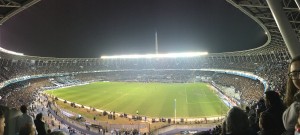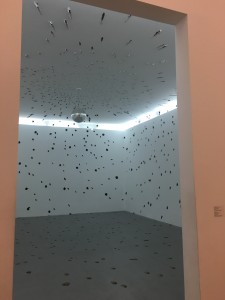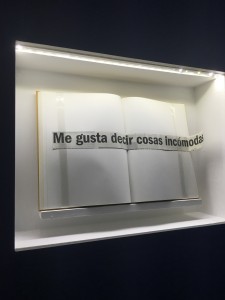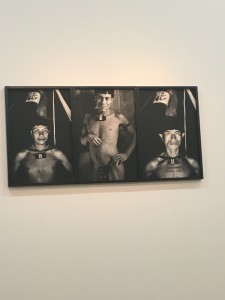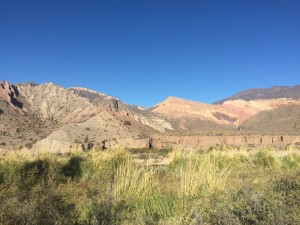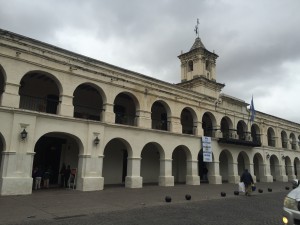On Saturday, the group was able to sleep in. A couple of us went to a quick restaurant and at 2:30 we left for a Racing soccer game. The bus ride was about 30 minutes and the bus quickly filled with Racing fans wearing light blue. Upon arriving, we got drinks and choripans and made our way to our section. The field was surrounded by a mote to prevent fans from running on the field. As kick off started to approach, the stands started to become very rowdy. People were passing blue and white plastic bags to blow up and wave around, while others were tearing up newspaper to make confetti. The atmosphere was lively the entire time as the fans were constantly singing chants and songs throughout the game. This game was also special because one of the players was retiring and this was their last game. The retiring of a soccer player is like a death and is a very big deal. There were many banners hanging around, people were passing out flyers with his name on it, and there was an honorary sign made displayed on the field. The team received 2 penalty kicks during the game and the retiring player was allowed to take both, and scored on 1 of the penalty kicks. We left early to avoid the crowds but there was even a ceremony to be held after the game for the player. Overall, seeing a soccer game is a must if you want to experience the heart and soul of Argentina. Soccer is essentially a religion here and an extremely important aspect of Argentina’s culture.
Month: May 2016
MALBA
On Tuesday, we departed from the hotel to the Museo de Arte Latinoamericano de Buenos Aires (MALBA). The museum is located in Palermo and was currently holding exhibitions by Jorge Macchi, Claudia Andujar Marcados, and more. The museum was small but very spacious in layout. My favorite collection (and many of my classmates) was Perspectiva by Argentine artist Jorge Macchi. The exhibition has pieces over the course of 25 years and has a lot of pieces that really cause one to think. It is hard to adequately describe his work because it spans such a wide period of time, but to me the pieces create atmospheres that waver between the metaphysical and mysterious. One of my favorite pieces had two contradictory movie clips playing and 3 different sound recordings that wonderfully meshed into a harsh but strangely beautiful harmony. Another was a room with a disco ball and holes cut into the wall that imitated the light shining from the disco ball. I loved that all his pieces were so unique and thought provoking. I also really enjoyed the pictures taken by Claudia Andujar Marcados. She took pictures of native Indians in 1980 in Brazil. Each Indian received a numbered tag to show they were vaccinated by doctors volunteering in the area. The work questions how we “brand” or label people. Even though this was positive for the Indians, Marcados experienced friends and family marked with a yellow star to be “branded for death” and this greatly influenced her 60 years later to make this exhibition. Overall, there was quite a range of pieces in the museum and many Argentinians were showcased. Many famous artists had works here and there was even a piece by Frida Kahlo. MALBA is incredibly important to the collection and preservation of Latin American artwork, and helps to educate the public on the culture.
Salta Day 2 & Salinas Grandes
On Saturday we went to Salinas Grandes, which is salt flat, located in the provinces of Salta and Jujuy. It is around 240 km2 and was a lake thousands of years ago that has since dried up and is now about a ½ km thick chunk of salt. There were also pools of water in the salt that are occasionally excavated to help separate the minerals from the salt.
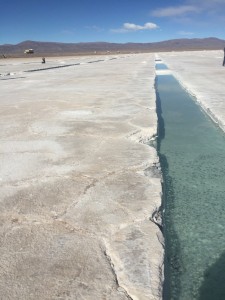 It was a very beautiful sight to see and was one of the most beautiful places in Argentina that we have visited. The light colors of the salt contrasts to the blue of the sky / water and the dark mountains in the background.
It was a very beautiful sight to see and was one of the most beautiful places in Argentina that we have visited. The light colors of the salt contrasts to the blue of the sky / water and the dark mountains in the background.
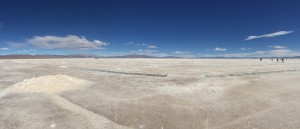 We stayed there for about half an hour and took lots of pictures and then had some time to buy crafts. There were venders selling sweaters that were made of llama fur, llamas and other figures made out of chunks of salt, llama keychains and all other things llama.
We stayed there for about half an hour and took lots of pictures and then had some time to buy crafts. There were venders selling sweaters that were made of llama fur, llamas and other figures made out of chunks of salt, llama keychains and all other things llama.
To get there we had to go through a lot of little villages which each had their own vendors selling everything llama. We even had the opportunity to take pictures with two llamas. We also went through many beautiful landscapes. We stopped at a lot of different villages and other spots to take pictures and to soak in the beauty. One of the other beautiful things was the many mountains that had different colors such as red, pink, blue/green, brown, grey, yellow and other mixes of colors that are made from oxygen reacting to different minerals.
Salta Day 1
On Friday, we had an early start to catch our 6:50 am flight to Salta. Our guide, Pablo, picked us up at the airport in Salta and started to introduce us to the area. We first went to a protected rainforest area. There, we were able to hike around and explore the beautiful scenery.
We then dropped our stuff off at the hotel and started a walking tour of the city. Pablo explained many of the important colonial architectural aspects of city. He also pointed out some places we might want to eat or shop during our stay.
We visited the San Framcisco Catholic Church. The building was colorful and displayed influences of Italian architecture. Inside there were many altars dedicated to various saints and a beautifully decorated rotunda.
We explored the center city square as well. The cabildo building (pictures below) is now a museum. The tower was an addition to the building and part of the building was destroyed to build a statue of Francisco Alvarez de Toledo and an additional town square.
On the main city square, we went to the Museum of Archeology (MAAM). The exhibits were focused on indigenous artifacts that had been discovered in Salta providence. These included pottery, tools, and cloth. There were also remains that were preserved in a mummy-like state of indigenous children. These children were found in the mountains near Salta.
We then had some time to catch up on sleep at the hotel before having dinner.
TANGO NIGHT
We learned that Tango is more than a dance, more than music– it is a language.
We knew that last Thursday night was going to be a long one, but it was completely worth it.
We began our night with a half-hour lesson filled with a lot of joyful mishaps and laughter. Of course, the number of women on this trip completely outnumbers the men. It is 2 to 6, so there were quite a few female couples, which made the night even more entertaining.
Most important lesson we learned: the partners in Tango must be one.
Our instructor, who was one of the stars of the show, told us you can tell if a couple is good based on how the sync of their movements. They speak to each other through music.
The man is to lead the woman and the woman can easily follow by feeling their partner’s shift in balance. That was the hardest part of the lesson to me… and also finding a way to move in a circle and not bump into everyone.
The tango lesson was another great way for us to live the Argentine culture and to actually be apart of it; instead of, observing it. We got to do a lot of that later.
After dinner and a whole lot of wine, a tango show began. Amazing does not even begin to describe the show.
Everyone seemed to enjoy the live music and the interaction of the dancers with the crowd. There were dancers dancing on the bar and they approached the stage from within the crowd. We all were a part of the story.
The story aspect is what I enjoyed the most. Each couple had their own dance, with their own pace, and the dances spoke for themselves, even though their was a screen with scene names.
The dinner was a traditional Argentine meal— BEEF, BEEF, and MORE BEEF (with some salad). Tango night was a night where we all were fully immersed in Argentine culture.
Rosana Simonassi: The Series of A Thousand Deaths
Nestled in the heart of the art district of Palermo, Rosana Simonassi creates her artwork from her second-story apartment.
“It’s interesting, but…amazing.”
Over her cup of matte tea, she used those to words to begin her description of the Buenos Aires art scene as friendly, great, and an essential aspect of the culture. It seems hidden, but yet it is visible in every aspect of the city from the politically-driven, territorial street art to the design on the boots of the ranch gauchos we had met earlier on that Tuesday.
I tuned in and out of her description because I was continuing to ponder over what was in my hands.
“A Series of A Thousand Deaths” was the title of a small booklet she handed us as we sat down in the living area of her apartment. Before I even saw the title or realized what was handed to me, I was striked by the blunt image on the front cover of a dead woman in the middle of a field.
As she spoke about her works over the honking and bustle of the streets outside her window, I was in deep thought over the meaning of these images.
From page to page, a dead woman was lying in the middle of something–from the side of a road in her hometown to the rooftop of her apartment building. The images had a cool tone and conveyed a sense of abandonment and disparity.
I finally asked why and in that moment is when she let us all see who she is as an artist.
The series was inspired by the death of her mother, which was two months before the birth of her first child. She was in a confused space, felt alone, and simultaneously, constantly presented with glamorized and over-sexualized images of woman in the media. Her series presents her sorrow, but also a social message of femininity.
I knew there was more behind the scenes, it was deep, and my respect for art became deeper than before.
Salta Day Two – The Andes Mountains and Salinas
On our second day in Salta, we took a bus tour of the Andes Mountains and got to experience multiple climates in a short amount of time. On the side of the Andes that the city of Salta resides, the climate is humid and very rainy, while on the other side of the mountains there is a desert climate. Millions of years ago, the area where the Andes Mountains would be was covered with the ocean until earthquakes resulted in the Andes. Then the ocean somehow drained from the area and left pools of salt water at the foot of the mountains.  However, due to the mountains’ altitude, they prevented moist winds from blowing over them, resulting in the salt-water pools evaporating over time, leaving the Salinas salt flats.
However, due to the mountains’ altitude, they prevented moist winds from blowing over them, resulting in the salt-water pools evaporating over time, leaving the Salinas salt flats.
 On our first few stops, the weather was cold, cloudy, and humid and there was a dense layer of fog/clouds surrounding the mountains that we could see. The views we had of the mountains there were beautiful and I liked how due to the altitude, they actually seemed to reach the clouds. As we continued to drive to the other side of the mountains, the sky was suddenly blue and the sun shone. It almost felt like we had driven to a different country completely.
On our first few stops, the weather was cold, cloudy, and humid and there was a dense layer of fog/clouds surrounding the mountains that we could see. The views we had of the mountains there were beautiful and I liked how due to the altitude, they actually seemed to reach the clouds. As we continued to drive to the other side of the mountains, the sky was suddenly blue and the sun shone. It almost felt like we had driven to a different country completely.
For the remainder of the drive our views remained the same, but they were still unbelievable. When we made it to the Salt flats in Salinas, the views were almost more breathtaking. The ground looked like it was covered in snow but it was actually a thick layer of salt left behind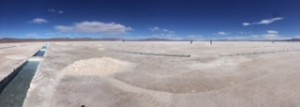 by the ocean millions of years ago. I think this was my favorite stop on the tour because I loved the contrast the white salt brought to the mountain views in the background. Overall, this was by far my favorite day of the trip to Buenos Aires. I love the culture of this country, but the views we saw on the bus tour are hard to beat.
by the ocean millions of years ago. I think this was my favorite stop on the tour because I loved the contrast the white salt brought to the mountain views in the background. Overall, this was by far my favorite day of the trip to Buenos Aires. I love the culture of this country, but the views we saw on the bus tour are hard to beat.
Boca Excursion
Today we rode the bus over to Boca, a neighborhood of Buenos Aires, to see their teams stadium and walk around a cool part of the neighborhood. When we got off the bus we walked straight over to Boca Jr’s stadium, the club that plays in Boca and many living near there root for. Boca Jr’s is one of the biggest and most famous clubs in Argentina’s history of football. They have won the Argentine league multiple times and boast some of the greatest football players of all time, like Diego Maradona.
As we were walking towards the stadium everything from peoples clothing to the buildings appeared to be blue and yellow, Boca Jr’s colors. When we reached the stadium we had half an hour to walk around their museum where they had video’s of great moments in their history, the trophies the team had won, and the best players to play in a Boca Jr’s uniform. After this we went on a tour of their stadium. You could feel the passion the tour guide had for Boca Jr’s and could see what this soccer team means to people in things even like the design of their stadium. The away team’s locker room is right underneath one of the rowdiest sections of the stadium, so before the game and during half time this section ensures they’re as loud as they can be as they jump around to annoy the opposing team underneath them. The tour guide was also telling us that the away section is at the highest level of the stadium, only has one bathroom for the 3000 fans it can fit and has no concessions to sell food to the fans. It’s crazy to see how the passion for football runs so deep in the Argentine people veins that they go to such lengths to help their team win.![IMG_6289[1]](https://u.osu.edu/argentinastudyabroadmay2015/files/2016/05/IMG_62891-2j4wf53-300x99.jpg) (Boca Jr’s stadium)
(Boca Jr’s stadium)
After the stadium tour we walked to the part of Boca that has shops. There we got lunch and looked around the different shops that were there. The buildings there seemed much older than the other places we had walked around so it was nice to see a different side of the city and it’s history compared to the areas right around our hotel.![IMG_6294[1]](https://u.osu.edu/argentinastudyabroadmay2015/files/2016/05/IMG_62941-1mzjacu-300x225.jpg) (old houses in the Boca neighborhood)
(old houses in the Boca neighborhood)
Estancia Santa Susana
The Estancia was about an hour out into the country side. It was a nice change of scenery from seeing the city every day. Once we arrived we were immediately greeted by one of the gauchos (cowboys!) with a kiss on the cheek as we were getting off the bus. We were also offered very delicious empanadas and a choice of a drink of white wine, red wine, or orange juice. As we ate our empanadas and had our drinks we got a tour of the house that the owners of the ranch used to live in. The house is now open as a museum for people to see. The house was very interesting and it was much bigger than I expected for a single floored house. There was also right next to the house a sort of chapel. This chapel was for when a priest would pass through so that a mass or baptism or confession can take place.
We then got a wagon ride, pulled by horses, throughout the property. On the wagon ride we saw some little owls hanging out in a hole in the ground! After the wagon ride we got to ride some horses. The horses took us around the estancia.
We then ate lunch. We ate so much. At this point we were offered pretty much whatever drink we wanted. We started our meal with bread, then multiple variations of salad, and potato salad. We ate sausages, then a type of sausage that had pigs blood, pigs fat, and some other parts of the pig wrapped inside of pigs skin, then bife de chorizo, chicken, and then a filet mignon. For desert we had flan accompanied with dulce de leche.
After lunch they put on a show for us. We watched people dance, we watched a man sing while playing a guitar, and some of us even got to dance with the gauchos. The show continued outside as well. We watched some gauchos on horses rounding them up. The gauchos then proceeded in doing an activity that used to happen for marriages. The gauchos ride the horse as it runs towards something that holds a ring up and then have to catch the ring with this pen looking thing. They would give the ring to a girl and that’s the wedding process.
Overall it was a fun day and it was very enjoyable.
ESMA Excursion
ESMA used to be an Argentine Navy school which doubled as a torture and detention center during Argentina’s last military dictatorship from 1976 through 1983. This time was known as the “dirty wars” and over these years an estimated 30,000 people were disappeared by the government. The people taking the others were far right-wing people associated with the government. They were taking, or “disappearing” as they were calling it here, left wing people associated with socialism, and torturing them to get information of more people who were associated with socialism. Eventually a majority of the people who were disappeared were killed.
Visiting ESMA you could feel the sadness and overall emotion associated with a cite where people were senselessly tortured and killed. Seeing the places where they were kept and how it was really in the middle of a giant city like Buenos Aires is shocking to say the least. Also the fact that everyone from the students to the officers at the naval school were forced to participate in the torturing of people makes it all the more real. On top of that other workers at the school must have felt gigantic dilemmas as they were seeing unfair treatment and torture of civilians like themselves at a government agency they work at. It’s hard for me to imagine a situation like this just because you would never really expect that it happened a little over thirty years ago in the same huge city that I am walking around today.
